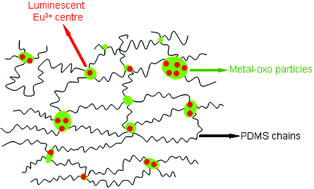Synthesis and optical properties of Eu3+-doped inorganic–organic hybrid materials based on siloxane networks
Abstract
Transparent polydimethylsiloxane–metal

* Corresponding authors
a Departamento de Química Inorgánica y Orgánica, Universitat Jaume I, Campus Riu Sec, Castellón, Spain
b
Laboratoire de Chimie de la Matière Condensée UMR-CNRS 7574, Université Pierre et Marie Curie, 4 place Jussieu 75252, Paris, France
E-mail:
clems@ccr.jussieu.fr
Transparent polydimethylsiloxane–metal

 Please wait while we load your content...
Something went wrong. Try again?
Please wait while we load your content...
Something went wrong. Try again?
B. Julián, R. Corberán, E. Cordoncillo, P. Escribano, B. Viana and C. Sanchez, J. Mater. Chem., 2004, 14, 3337 DOI: 10.1039/B410070K
To request permission to reproduce material from this article, please go to the Copyright Clearance Center request page.
If you are an author contributing to an RSC publication, you do not need to request permission provided correct acknowledgement is given.
If you are the author of this article, you do not need to request permission to reproduce figures and diagrams provided correct acknowledgement is given. If you want to reproduce the whole article in a third-party publication (excluding your thesis/dissertation for which permission is not required) please go to the Copyright Clearance Center request page.
Read more about how to correctly acknowledge RSC content.
 Fetching data from CrossRef.
Fetching data from CrossRef.
This may take some time to load.
Loading related content
